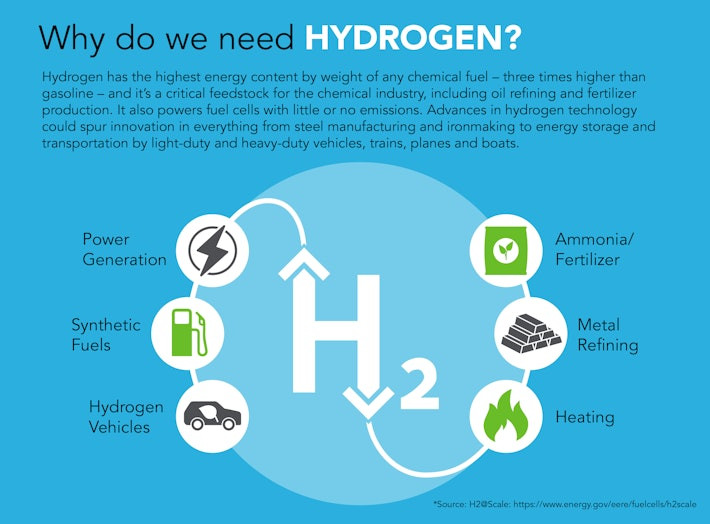Green hydrogen was the buzzword on everyone’s lips a couple of years ago, but the initial hype seems to have faded away as the industry takes time to build capacity and overcome production and transportation hurdles. Several countries have set out ambitious green hydrogen production aims for the coming decades, as they strive to decarbonise hard-to-abate industries. However, as governments and the private sector increase investments in green hydrogen, the sector is taking time to develop. Researchers are constantly looking at ways to reduce production costs, which are elevated at present, as well as overcome transport restrictions. While there are high hopes for the development of a global green hydrogen market, it could take a decade or more before we see greater production and use of the clean fuel.
Green hydrogen can be produced cleanly using wind- or solar-powered electricity to power electrolysis, which splits hydrogen and water. Unlike conventional hydrogen, it does not require the use of fossil fuels to power the production process. As investment in green hydrogen continues to rise, with governments worldwide pushing for a green transition and the decarbonization of hard-to-abate industries, the green hydrogen market is expected to reach a value of $1.4 trillion market by 2050. A 2023 outlook by Deloitte estimated that green hydrogen could become competitive in under a decade, supporting up to 2 million jobs globally every year between 2030 and 2050. The main market driver will be the decarbonization of industries such as steelmaking, chemicals, aviation, and shipping. Deloitte expects Asia to own around 55 percent of the green hydrogen market by 2030, dominated by China, India, and Indonesia.
Green Hydrogen's Promise
Green hydrogen appears an increasingly attractive option for industries that generate high greenhouse gas emissions and cannot rely on clean electricity to reduce emissions. Clean hydrogen could help reduce cumulative carbon emissions by up to 85 gigatons by 2050, equivalent to over twice the global CO2 emissions in 2021. However, Deloitte estimated that over $9 trillion of cumulative investments are required in the global clean hydrogen supply chain to help achieve the net-zero outlook by 2050.
The Challenges Facing Green Hydrogen
While there is significant potential for the growth of the global green hydrogen industry, there is still a long way to go before we see the widescale production and uptake of the energy source. Governments and energy companies are investing heavily in the development of green hydrogen technologies to boost global production capacity. The EU aims to produce 10 million metric tonnes of carbon-free hydrogen by the end of the decade and import around the same amount. In the U.S., President Biden has invested $8 billion in the certation of “hydrogen hubs,” clusters of businesses that produce and use the fuel. However, to date, the green hydrogen industry has attracted few customers.
Most of the current purchase agreements for green hydrogen are nonbinding, meaning that buyers can back out at any minute. This means that much of the impressive green hydrogen pipeline may never get built. Only around 12 percent of “low-carbon hydrogen plants” have customer agreements for fuel purchase. The BloombergNEF analyst Martin Tengler explained, “No sane project developer is going to start producing hydrogen without having a buyer for it, and no sane banker is going to lend money to a project developer without reasonable confidence that someone’s going to buy the hydrogen.”
The High Cost of Green Hydrogen
Green hydrogen is seen as pivotal to the global green transition, as potentially the only means of decarbonizing steel, maritime shipping, and other hard-to-abate industries that cannot rely on clean electricity alone. In fact, we may be using as much as 390 million tons of hydrogen per year globally by 2050. However, making the switch from fossil fuels or conventional hydrogen to green hydrogen is not so simple.
Companies looking to transition to green hydrogen would need to invest in expensive equipment, and the cost of clean hydrogen production remains four times higher than that of grey/blue hydrogen, which relies on natural gas. Further, developing the infrastructure needed to transport the hydrogen, such as new or adapted pipelines, is not so simple. Hydrogen must be supercooled for transport, which means compressing it or carrying it in another form such as ammonia, which combines hydrogen with nitrogen. While the construction of pipelines can help connect domestic customers to plants, it is more complicated to reach international customers, with no well-established regional transport links.
The Future of Green Hydrogen
There is significant potential for the development of the green hydrogen industry, with many energy experts viewing the clean fuel as the only possible way to decarbonize heavy industries. However, to accelerate the development of the market, private companies worldwide must establish meaningful agreements with producers to ensure their projects can get off the ground. Without greater investment in the sector and guarantees of green hydrogen uptake across several major industries, the sector could stagnate, which would harm decarbonization aims in the coming decades.

















